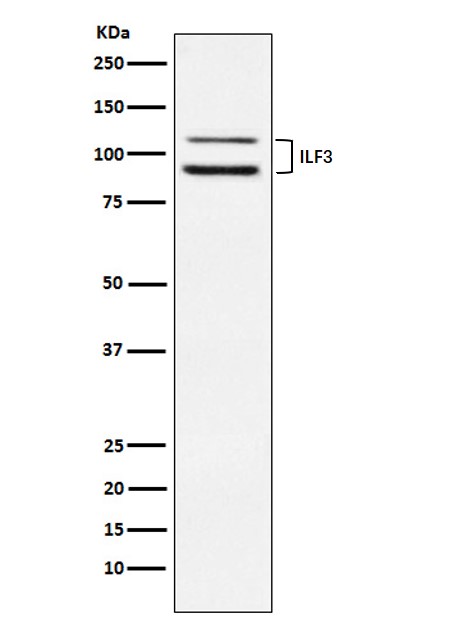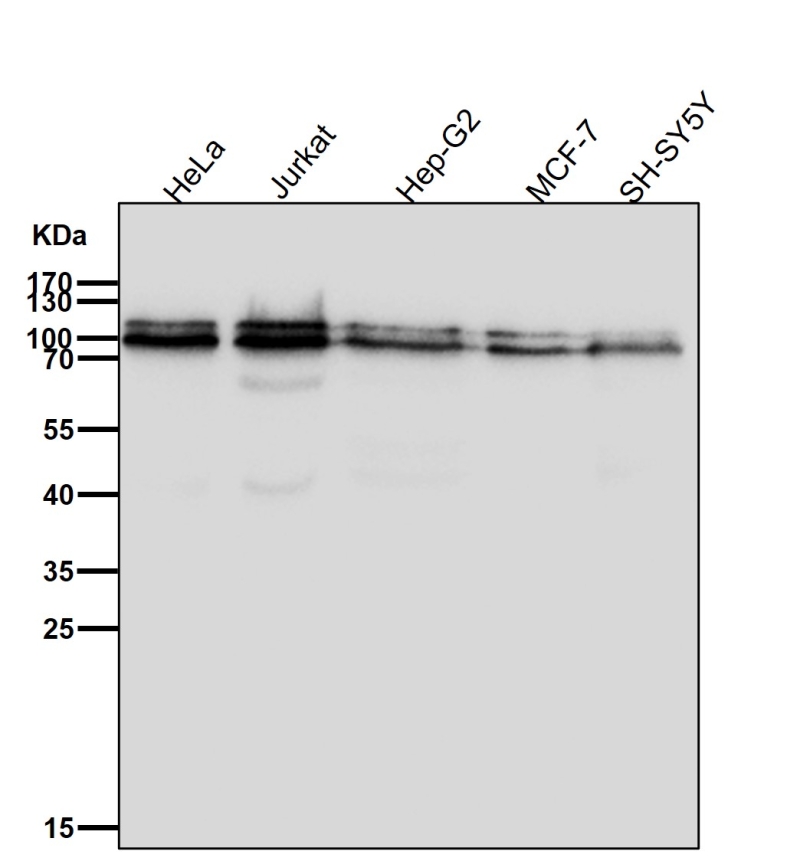

| WB | 1/1000-1/2000 | Human,Mouse,Rat |
| IF | 1/20-1/50 | Human,Mouse,Rat |
| IHC | IHC:1/100-1/200;IHF:1/50-1/200 | Human,Mouse,Rat |
| ICC | 1/50-1/200 | Human,Mouse,Rat |
| FCM | 1/20-1/100 | Human,Mouse,Rat |
| Elisa | 咨询技术 | Human,Mouse,Rat |
| Aliases | CBTF; DRBF; MMP4; MPP4; NF90; NFAR; NF110; NF90a; NF90b; NFAR2;TCP80; DRBP76; NF110b; NFAR-1; TCP110; MPHOSPH4; NF-AT-90;;ILF3 |
| WB Predicted band size | Calculated MW: 95 kDa ; Observed MW: 95,110 kDa |
| Host/Isotype | Rabbit IgG |
| Antibody Type | Primary antibody |
| Storage | Store at 4°C short term. Aliquot and store at -20°C long term. Avoid freeze/thaw cycles. |
| Species Reactivity | Human,Mouse |
| Immunogen | A synthesized peptide derived from human ILF3 |
| Formulation | Purified antibody in PBS with 0.05% sodium azide,0.05% BSA and 50% glycerol. |
+ +
以下是关于ILF3抗体的参考文献示例,涵盖不同研究领域:
---
1. **文献名称**:*ILF3/NF90 Stabilizes Oncogenic Transcripts in Human Gastric Cancer*
**作者**:Li, X., et al.
**摘要**:该研究通过Western blot和免疫组化(使用ILF3抗体)分析,揭示了ILF3通过结合并稳定促癌RNA(如MYC mRNA)促进胃癌进展的机制,表明其可作为潜在治疗靶点。
2. **文献名称**:*NF90/ILF3 Interacts with RNA Sensors to Regulate Antiviral Innate Immunity*
**作者**:Smith, J.L., et al.
**摘要**:研究利用ILF3抗体进行免疫共沉淀和RNA结合实验,发现ILF3通过与RIG-I和MDA5相互作用增强病毒RNA识别,调控抗病毒信号通路,为抗病毒治疗提供新思路。
3. **文献名称**:*ILF3 Modulates TDP-43 Proteinopathy in ALS through RNA Metabolism*
**作者**:Chen, Y., et al.
**摘要**:通过免疫荧光(使用ILF3抗体)和蛋白质组学分析,该文阐明ILF3在肌萎缩侧索硬化症(ALS)中与TDP-43异常聚集的关联,提示其参与神经退行性病变的RNA调控机制。
4. **文献名称**:*ILF3 Coordinates Cell Cycle Progression via DNA Damage Response*
**作者**:Wang, Q., et al.
**摘要**:研究使用ILF3抗体进行染色质免疫沉淀(ChIP)和流式细胞术,发现ILF3通过调控DNA损伤修复相关基因的转录,影响细胞周期检查点激活,维持基因组稳定性。
---
**注**:以上文献信息为示例性质,实际引用时需核对具体来源及准确性。建议通过PubMed或Google Scholar以关键词“ILF3 antibody”或“NF90 antibody”检索最新文献。
ILF3 (Interleukin Enhancer Binding Factor 3), also known as NF90. is a double-stranded RNA-binding protein involved in diverse cellular processes, including transcriptional regulation, RNA metabolism, and immune response. It belongs to the NF90/NF110 protein family, characterized by conserved RNA-binding domains and roles in post-transcriptional gene regulation. ILF3 interacts with RNA, DNA, and proteins, functioning in both nuclear and cytoplasmic compartments. In the nucleus, it modulates transcription by binding to promoters or enhancers of cytokine genes (e.g., interleukin-2). In the cytoplasm, it regulates mRNA stability, translation, and microRNA processing, impacting viral defense and stress responses.
ILF3 antibodies are essential tools for studying its expression, localization, and molecular interactions. They are widely used in techniques like Western blotting, immunofluorescence, immunoprecipitation, and chromatin immunoprecipitation (ChIP). Research has linked ILF3 dysregulation to cancers, autoimmune disorders, and viral infections, where it may influence tumor progression, immune activation, or viral replication. Antibodies targeting specific ILF3 isoforms (e.g., NF90/NF110) or post-translational modifications help elucidate its context-dependent roles. Due to its functional versatility, ILF3 remains a focus in exploring RNA biology, antiviral mechanisms, and therapeutic targets.
×